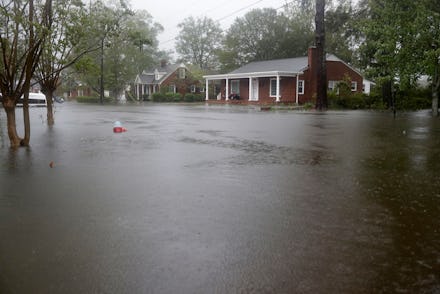Hurricane Florence could devastate poor communities of color, experts warn

As Hurricane Florence, now downgraded to a tropical storm, continued to chart a path of destruction across North and South Carolina on Saturday, school gymnasiums morphed into makeshift shelters for thousands of people displaced from their homes in nearby flood-prone areas.
But for many residents in the low-income communities most threatened by the storm’s wake of devastation, evacuation was never a possibility.
“Some people are getting out of town, but that’s not an option for me. I have no money, no job, no connections,” Tony Clower, a homeless Kinston, North Carolina, resident, told the Asheville Citizen-Times.
Nakisa Glover, a National Climate Justice Fellow at Hip Hop Caucus based in North Carolina, said in a phone interview that while the mandatory evacuation orders might make “logical sense in theory, if you don’t have the resources, you can’t just leave your home in a lot of cases.”
“It costs to leave,” Glover, who also founded the environmental justice organization Sol Nation, continued. “There is a cost to rebuild. There is a cost to the devastation that an ecological event like this has on a community. And so if you already were a community that was under-resourced, this puts a greater strain on your community, having storms like this.”
By Saturday, Florence’s death toll had already risen to seven. The price tag on the rebuild efforts for areas devastated by storm surge, which was expected to reach as high as 20 feet in some areas, was still impossible to quantify. But even before the storm made landfall as a Category 1 hurricane on Friday, experts were warning that low-income neighborhoods were already poised to bear the brunt of its ruination.
“With a storm like this, you have communities that are faced not only with the devastation that a storm like this will leave behind, but the environmental injustices that may have already been existing in those communities,” Glover said.
The small town of Hamlet in Richmond County, North Carolina, for example, is full of toxic emitters: within its borders are a chicken processing plant, an energy company and a wood pellet manufacturer that broke ground within the past few years. The area is also a connecting point for the Atlantic Coast Pipeline, which crews were rushing to fortify on Monday amid fears that extreme environmental stressors could damage the natural gas transporter.
According to a Brookings Institution article written in the wake of Hurricane Harvey, which walloped southeast Texas in 2017, poor, minority families are more likely to live in low-lying neighborhoods like Hamlet that are already host to industrial facilities or environmental hazards — the same low-income neighborhoods that are far less likely to be inoculated from severe weather events.
It’s part of the same pattern that unfolded during Hurricane Katrina, when some 150,000 to 200,000 people remained in their homes despite federal evacuation orders, and during Hurricane Maria, which an independent study conducted by George Washington University recently revealed resulted in nearly 3,000 deaths.
Despite the predictability of low-income communities being hit hardest by natural disasters, it remains a documented phenomenon that the national news media largely turns a blind eye to the devastation being wrought in poor neighborhoods.
Glover speculated that part of the problem could stem from an “until I can get to higher ground and make sure my family is safe, I can’t talk to media,” mindset.
“Maybe the communities of color that are expected to feel the greatest burden of a disaster like this don’t have time to have a conversation like this with the media because they’re fighting for their lives, they’re fighting for their very survival,” she said.